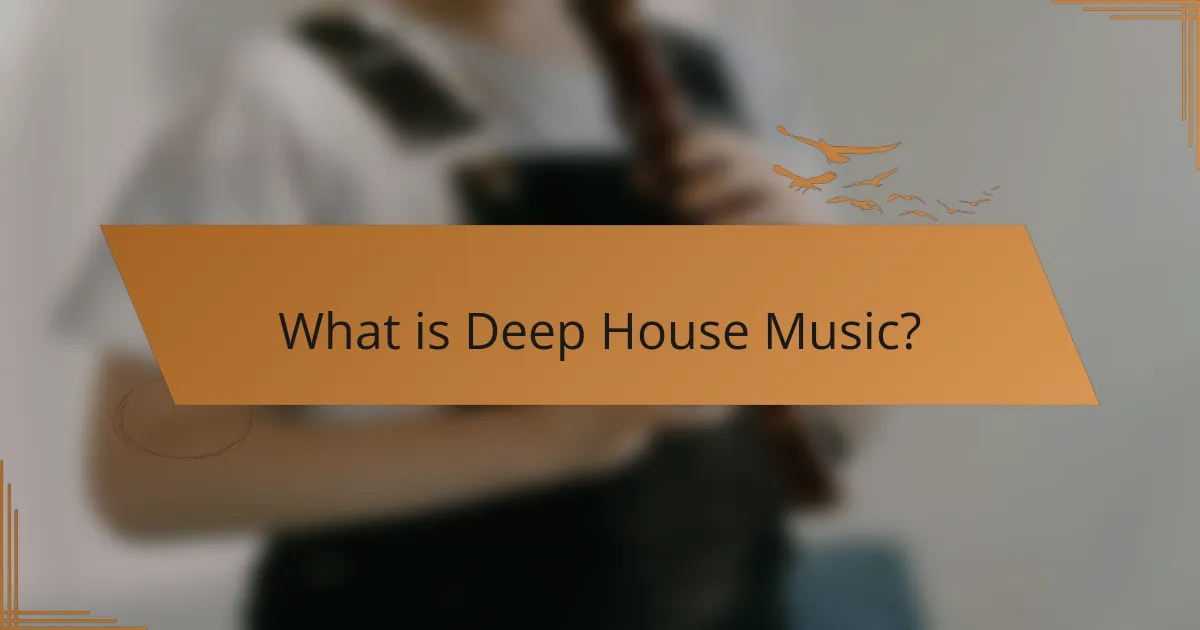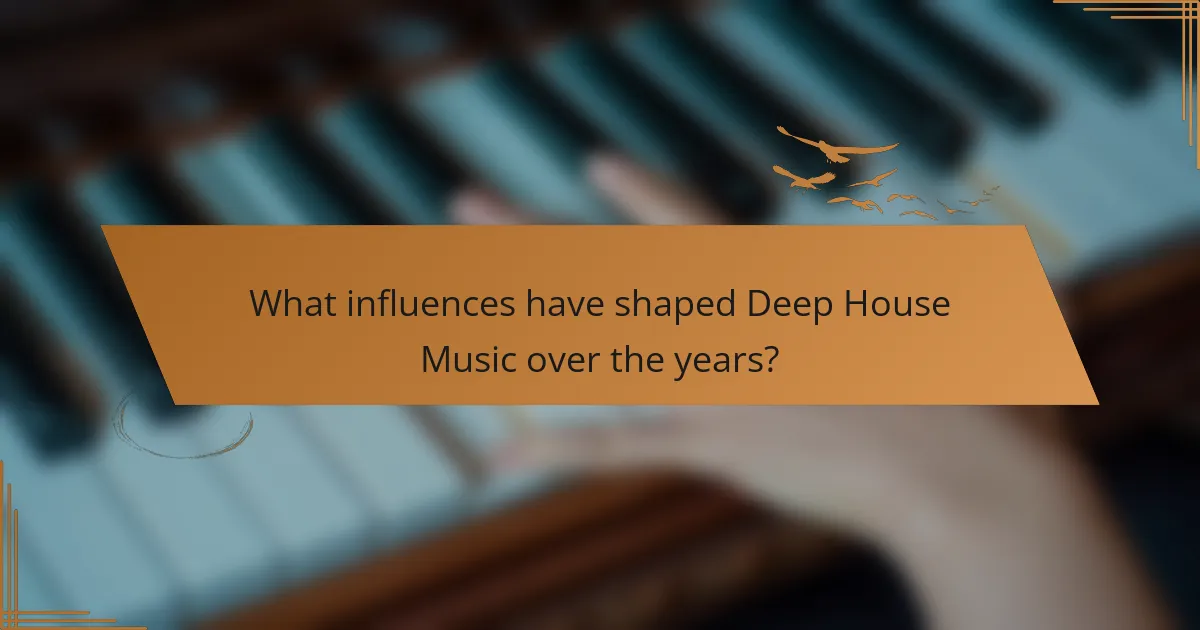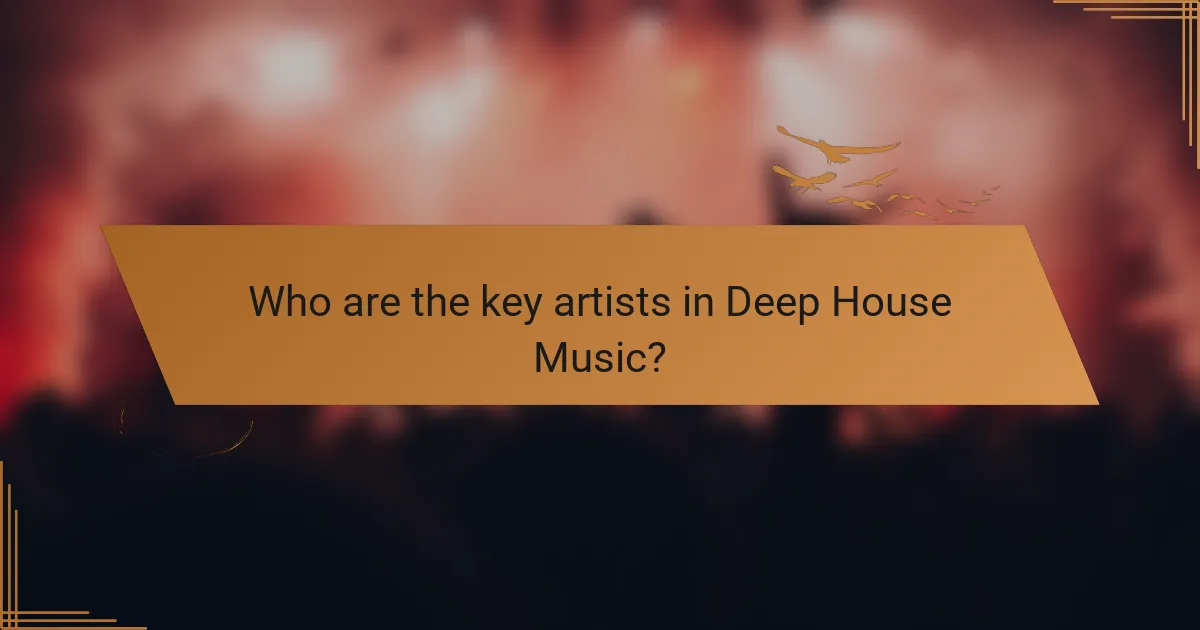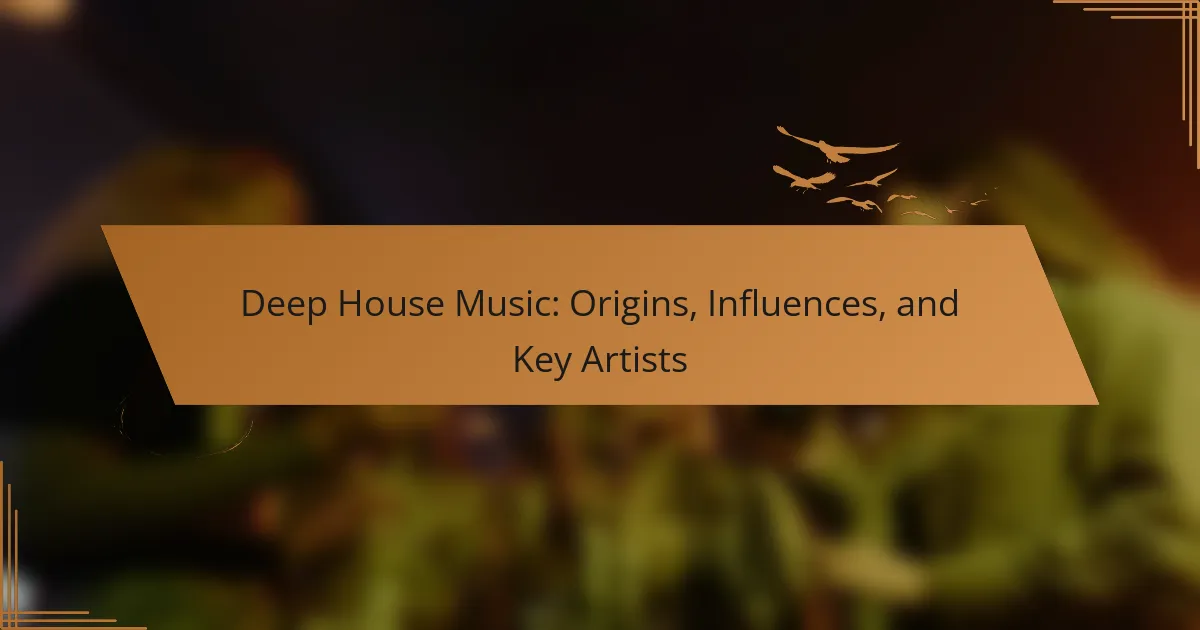Deep House Music is a subgenre of house music that emerged in the 1980s, primarily in Chicago and New York. It is characterized by complex melodies, soulful vocals, deep basslines, and atmospheric sounds, typically featuring a tempo of 120 to 125 beats per minute. Influenced by jazz, funk, and soul, the genre has evolved significantly over the years, with key artists such as Larry Heard, Kerri Chandler, and Frankie Knuckles playing crucial roles in its development. The article will explore the origins of Deep House, its musical influences, and highlight the contributions of notable artists who have shaped its sound and legacy.

What is Deep House Music?
Deep House Music is a subgenre of house music characterized by its complex melodies and soulful vocals. It originated in the 1980s, primarily in Chicago and New York. Deep House incorporates elements of jazz, funk, and soul. The genre is known for its slower tempo, typically ranging from 120 to 125 beats per minute. It often features deep basslines and atmospheric sounds. Key artists include Larry Heard and Kerri Chandler, who played significant roles in its development. The genre has evolved, influencing various music styles and scenes globally.
How did Deep House Music originate?
Deep House Music originated in the 1980s as a subgenre of house music. It emerged primarily from Chicago’s house scene. Influential artists like Frankie Knuckles and Larry Heard played pivotal roles in its development. Deep house is characterized by its complex melodies and soulful vocals. The genre incorporates elements of jazz, funk, and soul music. It gained popularity in clubs and underground parties. By the 1990s, deep house had spread to Europe, especially in the UK and Germany. Its distinct sound has influenced many electronic music genres since then.
What cultural influences shaped the beginnings of Deep House Music?
Deep House Music emerged from a blend of cultural influences, particularly from Chicago house music and disco. The genre was shaped by the African American and Latino communities in Chicago during the 1980s. These communities contributed to the rhythmic and soulful elements that define deep house. Disco’s influence brought lush melodies and vocal harmonies, creating a more emotional sound. Jazz and funk also played significant roles, adding complexity and groove to the music. The use of synthesizers and drum machines became prevalent, driven by technological advancements in music production. Deep house music reflects themes of love, unity, and [censured], resonating with the cultural experiences of its creators. These influences collectively established a unique sound that distinguished deep house from other electronic music genres.
Who were the pioneers of Deep House Music?
The pioneers of Deep House Music include Larry Heard, Frankie Knuckles, and Mr. Fingers. Larry Heard, also known as Mr. Fingers, is credited with shaping the sound of deep house in the mid-1980s. His track “Can You Feel It” is considered a seminal deep house record. Frankie Knuckles, known as the “Godfather of House,” played a significant role in the genre’s development in Chicago. He is famous for his remixes and productions that incorporated soulful elements. Other influential figures include Kerri Chandler and David Morales, who contributed to the genre’s evolution and popularity. Their work laid the foundation for deep house music as a distinct style within the broader house genre.
What are the defining characteristics of Deep House Music?
Deep House Music is characterized by its smooth, melodic sound and deep basslines. It typically features slower tempos, often ranging from 120 to 125 beats per minute. The genre incorporates elements of jazz, soul, and funk, creating a warm and inviting atmosphere. Vocal samples are frequently used, adding emotional depth to the tracks. The production often includes lush synths and atmospheric pads, enhancing the immersive experience. Deep House emerged in the 1980s, influenced by Chicago house music and Detroit techno. Its defining characteristics have made it a staple in clubs and lounges worldwide. The genre continues to evolve while maintaining its core attributes.
How does the tempo and rhythm differentiate Deep House from other genres?
Deep House is characterized by a slower tempo and unique rhythm patterns. Typically, Deep House tracks range from 120 to 125 beats per minute. This tempo creates a relaxed and groovy feel, distinguishing it from genres like Techno, which often exceeds 130 BPM. The rhythm in Deep House incorporates syncopated basslines and smooth, melodic elements. These rhythmic features contribute to a more laid-back atmosphere compared to the driving beats of genres like House or Trance. Additionally, Deep House often employs intricate hi-hat patterns and percussive elements that enhance its distinct sound. This combination of slower tempo and complex rhythms sets Deep House apart from other electronic music genres.
What instruments and sounds are commonly used in Deep House Music?
Deep House Music commonly uses synthesizers, drum machines, and basslines. Synthesizers create rich, atmospheric sounds that define the genre. Drum machines provide steady beats that are essential for the rhythm. Basslines in Deep House are often deep and groovy, adding to the overall vibe. Other instruments include electric pianos and guitars, which contribute to the melodic elements. Vocal samples are frequently used to enhance the emotional connection in tracks. The combination of these instruments creates the signature sound of Deep House Music.

What influences have shaped Deep House Music over the years?
Deep House Music has been shaped by various influences over the years. Key influences include jazz, soul, and funk, which contributed to its melodic and harmonic structures. The Chicago house scene in the 1980s played a pivotal role in its development. Artists like Larry Heard and Frankie Knuckles were instrumental in defining the genre’s sound. The incorporation of elements from ambient music also influenced its atmospheric qualities. Additionally, the rise of technology in music production allowed for innovative sound design. The global spread of electronic music culture further diversified deep house styles. This genre has evolved through collaborations and remixes, enriching its musical landscape.
How has technology impacted the evolution of Deep House Music?
Technology has significantly impacted the evolution of Deep House Music. The introduction of digital audio workstations (DAWs) revolutionized music production. Artists can now create complex sounds from their home studios. This accessibility has led to an explosion of new Deep House tracks. Synthesizers and drum machines have expanded the genre’s sonic palette. The internet has facilitated global collaboration among artists. Streaming platforms have changed how listeners access and discover music. Social media allows for real-time engagement with fans and promotion of new releases. These technological advancements have collectively shaped the modern Deep House landscape.
What role do digital audio workstations play in Deep House production?
Digital audio workstations (DAWs) are essential tools in Deep House production. They allow producers to record, edit, and arrange music digitally. DAWs provide a platform for manipulating audio tracks and MIDI data. This flexibility enables the creation of complex soundscapes typical of Deep House. Popular DAWs like Ableton Live and Logic Pro offer specialized features for electronic music. They include built-in synthesizers, effects, and sampling capabilities. These features facilitate the layering of sounds and the crafting of unique beats. The integration of virtual instruments enhances creativity in Deep House music. Overall, DAWs streamline the production process and elevate the quality of the final product.
How has the rise of streaming services changed the accessibility of Deep House Music?
The rise of streaming services has significantly increased the accessibility of Deep House Music. These platforms allow users to access vast libraries of music instantly. Listeners can discover Deep House tracks from around the world with just a few clicks. Streaming services also enable curated playlists focused on Deep House genres. This exposure helps emerging artists gain recognition. According to a 2021 report, streaming accounted for over 80% of music consumption in the U.S. The ease of sharing and recommending tracks enhances community engagement around Deep House Music. Overall, streaming has democratized access to this genre, making it more popular than ever.
What genres have influenced the sound of Deep House Music?
Deep House Music has been influenced by several genres. Key influences include Chicago House, which laid the groundwork for its sound. Detroit Techno contributed its rhythmic elements and production techniques. Jazz and Soul music added rich harmonies and vocal styles. Funk introduced groovy basslines and rhythmic complexity. Disco’s influence is evident in its danceable beats and melodic structures. These genres collectively shaped the deep, emotive sound characteristic of Deep House Music.
How does Soul Music contribute to the essence of Deep House?
Soul music significantly influences the essence of deep house. It introduces emotional depth and rich vocal expressions. Deep house often incorporates soulful melodies and harmonies. These elements create an immersive listening experience. Additionally, soul music’s rhythmic patterns enhance the groove of deep house tracks. The genre relies on samples and influences from classic soul records. This connection roots deep house in a rich musical tradition. The combination of these characteristics defines the unique sound of deep house.
What elements of Jazz can be found in Deep House Music?
Deep House Music incorporates several elements of Jazz. These elements include complex chord progressions, which are a hallmark of Jazz. Jazz-influenced Deep House often features improvisational melodies. Syncopated rhythms are also prevalent, creating a groove typical in both genres. Additionally, the use of acoustic instruments, like saxophones and pianos, adds a Jazz feel to Deep House tracks. Vocal samples often draw from Jazz standards, enhancing the genre’s connection. The blending of these elements creates a unique fusion that appeals to fans of both styles.

Who are the key artists in Deep House Music?
Key artists in Deep House Music include Larry Heard, known for his influential track “Can You Feel It.” Another significant artist is Kerri Chandler, recognized for his deep, soulful sound. Maya Jane Coles has made a substantial impact with her unique production style. Also notable is Franky Knuckles, often referred to as the “Godfather of House,” who helped shape the genre’s early sound. Other important figures include Derrick Carter and Osunlade, both celebrated for their contributions to the deep house scene. Each artist has left a lasting legacy through their innovative music and production techniques.
Which artists are considered pioneers of Deep House Music?
Larry Heard, also known as Mr. Fingers, is considered a pioneer of Deep House music. His track “Can You Feel It,” released in 1986, is a defining piece of the genre. Another influential artist is Frankie Knuckles, often referred to as the “Godfather of House.” He played a crucial role in shaping the sound of Deep House in the 1980s. Additionally, Kerri Chandler is recognized for his contributions, particularly with tracks like “Bar A Thym.” These artists laid the foundation for Deep House music and influenced countless others in the genre. Their work is characterized by soulful melodies and intricate rhythms, which are hallmarks of Deep House.
What contributions did Frankie Knuckles make to the genre?
Frankie Knuckles significantly influenced deep house music. He is often referred to as the “Godfather of House.” Knuckles pioneered the genre in the 1980s at the Warehouse in Chicago. He blended disco, soul, and electronic music to create a unique sound. His remixes and productions set new standards for house music. Notable tracks include “Your Love” and “Baby Wants to Ride.” Knuckles’ use of synthesizers and drum machines shaped the genre’s sonic landscape. His contributions helped popularize house music globally, influencing countless artists and producers.
How did Larry Heard influence the sound of Deep House Music?
Larry Heard significantly influenced the sound of Deep House Music through his innovative production techniques and musical style. He is known for blending elements of jazz, soul, and electronic music. His track “Can You Feel It,” released in 1986, is a seminal deep house anthem. This track showcased lush, melodic chords and a deep, rolling bassline, setting a template for the genre. Heard’s use of live instrumentation and emotive vocals added a unique warmth to his productions. His work helped establish deep house as a distinct subgenre within house music. Additionally, Heard’s collaborations and remixes further expanded the reach of deep house. His influence can be heard in the works of numerous artists who followed, solidifying his legacy in the genre.
What contemporary artists are shaping the future of Deep House Music?
Contemporary artists shaping the future of Deep House Music include Ben Böhmer, Nora En Pure, and Lane 8. Ben Böhmer is known for his melodic and atmospheric soundscapes. He gained popularity with tracks like “Breathing” and “Beyond Beliefs.” Nora En Pure combines deep house with elements of nature and organic sounds. Her track “Come With Me” exemplifies her unique style. Lane 8 focuses on emotional storytelling through music, evident in his “Little By Little” album. These artists are influencing the genre’s evolution with their innovative approaches and distinctive sounds. Their contributions are regularly featured in festivals and playlists, showcasing their impact on Deep House Music.
How do artists like Disclosure and Kaytranada redefine Deep House today?
Artists like Disclosure and Kaytranada redefine Deep House by incorporating diverse genres and innovative production techniques. Disclosure blends elements of pop and garage, creating accessible tracks that appeal to mainstream audiences. Their hit “Latch” features a catchy vocal hook, showcasing their ability to merge deep house with pop sensibilities. Kaytranada, on the other hand, integrates funk, R&B, and hip-hop into his deep house tracks. His album “99.9%” exemplifies this fusion with groovy basslines and rhythmic diversity. Both artists utilize modern technology and sampling, pushing the boundaries of traditional deep house. Their unique approaches attract new listeners while retaining the genre’s core elements. This evolution reflects the genre’s adaptability in the contemporary music landscape.
What emerging artists should listeners watch in the Deep House scene?
Emerging artists to watch in the Deep House scene include Anjunadeep’s Ben Böhmer. His melodic tracks have gained significant traction. Another notable artist is Nora En Pure, known for her unique blend of deep house and natural sounds. Additionally, the duo Tinlicker has been making waves with their emotive soundscapes. Their releases have received critical acclaim. Lastly, the artist DJ Tennis has been recognized for his innovative approach to deep house music. Their contributions are reshaping the genre’s landscape.
What are some tips for discovering new Deep House Music?
Explore online music platforms like SoundCloud and Mixcloud. These platforms feature numerous deep house artists and mixes. Follow playlists curated by deep house enthusiasts. Spotify and Apple Music offer genre-specific playlists that are updated regularly. Attend local music events or clubs that focus on deep house. Live events often showcase emerging artists. Join online communities and forums dedicated to deep house music. Engaging with fellow fans can lead to new discoveries. Utilize music discovery apps like Shazam to identify songs you enjoy. These tools can help you find similar tracks or artists.
How can listeners find underground Deep House tracks and artists?
Listeners can find underground Deep House tracks and artists through various online platforms and communities. Websites like SoundCloud and Bandcamp host many independent artists. These platforms often feature niche genres, including underground Deep House. Social media groups and forums dedicated to electronic music can also provide recommendations. Platforms like Reddit have dedicated threads for sharing underground music. Additionally, attending local music events and festivals can connect listeners with underground artists. Many underground artists also release music on vinyl, which can be found at specialized record stores. Following music blogs that focus on underground scenes can yield new discoveries. These methods collectively enhance access to the underground Deep House music scene.
What playlists or platforms are best for exploring Deep House Music?
Spotify, SoundCloud, and YouTube are the best platforms for exploring Deep House Music. Spotify offers curated playlists like “Deep House Relax” and “Chill House.” SoundCloud features user-generated mixes and tracks from emerging artists. YouTube has channels dedicated to Deep House, such as “Selected.” These platforms provide access to a wide range of tracks and mixes. They help listeners discover both classic and contemporary Deep House sounds. Each platform offers unique features, enhancing the exploration experience.
Deep House Music is a subgenre of house music that emerged in the 1980s, characterized by complex melodies, soulful vocals, and a slower tempo ranging from 120 to 125 beats per minute. The genre blends elements of jazz, funk, and soul, with key artists such as Larry Heard and Frankie Knuckles playing pivotal roles in its development. The article explores the origins of Deep House, its cultural influences, defining characteristics, and the impact of technology on its evolution. Additionally, it highlights contemporary artists shaping the genre and offers tips for discovering new tracks and artists within the Deep House scene.
